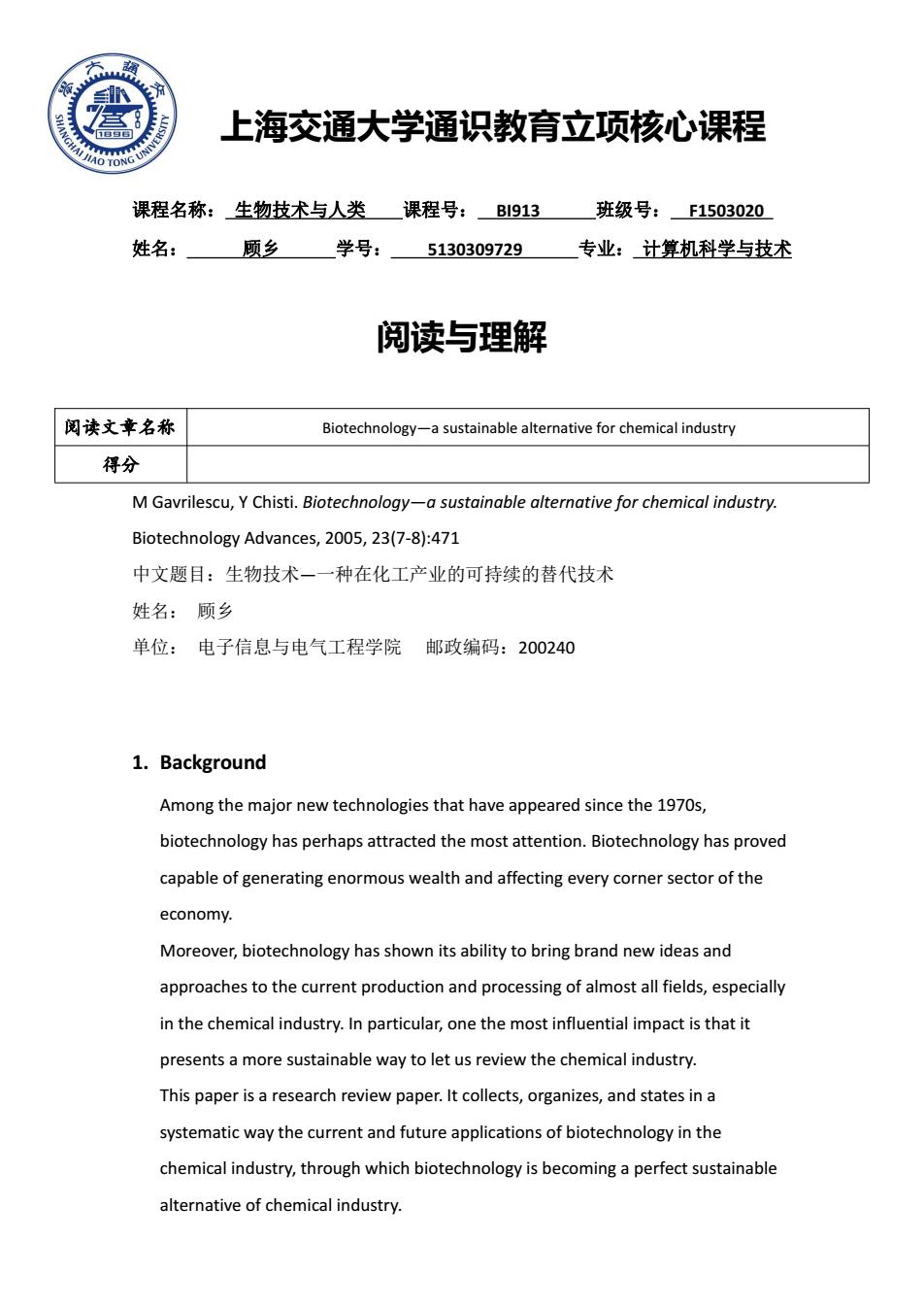
上海交通大学通识教育立项核心课程 课程名称:生物技术与人类课程号:B1913 班级号:F1503020 姓名: 顾乡 学号: 5130309729 专业:计算机科学与技术 阅读与理解 阅读文章名称 Biotechnology-a sustainable alternative for chemical industry 得分 M Gavrilescu,Y Chisti.Biotechnology-a sustainable alternative for chemical industry. Biotechnology Advances,2005,23(7-8):471 中文题目:生物技术一一种在化工产业的可持续的替代技术 姓名:顾乡 单位:电子信息与电气工程学院邮政编码:200240 1.Background Among the major new technologies that have appeared since the 1970s, biotechnology has perhaps attracted the most attention.Biotechnology has proved capable of generating enormous wealth and affecting every corner sector of the economy. Moreover,biotechnology has shown its ability to bring brand new ideas and approaches to the current production and processing of almost all fields,especially in the chemical industry.In particular,one the most influential impact is that it presents a more sustainable way to let us review the chemical industry. This paper is a research review paper.It collects,organizes,and states in a systematic way the current and future applications of biotechnology in the chemical industry,through which biotechnology is becoming a perfect sustainable alternative of chemical industry
上海交通大学通识教育立项核心课程 课程名称: 生物技术与人类 课程号: BI913 班级号: F1503020 姓名: 顾乡 学号: 5130309729 专业: 计算机科学与技术 阅读与理解 阅读文章名称 Biotechnology—a sustainable alternative for chemical industry 得分 M Gavrilescu, Y Chisti. Biotechnology—a sustainable alternative for chemical industry. Biotechnology Advances, 2005, 23(7-8):471 中文题目:生物技术—一种在化工产业的可持续的替代技术 姓名: 顾乡 单位: 电子信息与电气工程学院 邮政编码:200240 1. Background Among the major new technologies that have appeared since the 1970s, biotechnology has perhaps attracted the most attention. Biotechnology has proved capable of generating enormous wealth and affecting every corner sector of the economy. Moreover, biotechnology has shown its ability to bring brand new ideas and approaches to the current production and processing of almost all fields, especially in the chemical industry. In particular, one the most influential impact is that it presents a more sustainable way to let us review the chemical industry. This paper is a research review paper. It collects, organizes, and states in a systematic way the current and future applications of biotechnology in the chemical industry, through which biotechnology is becoming a perfect sustainable alternative of chemical industry
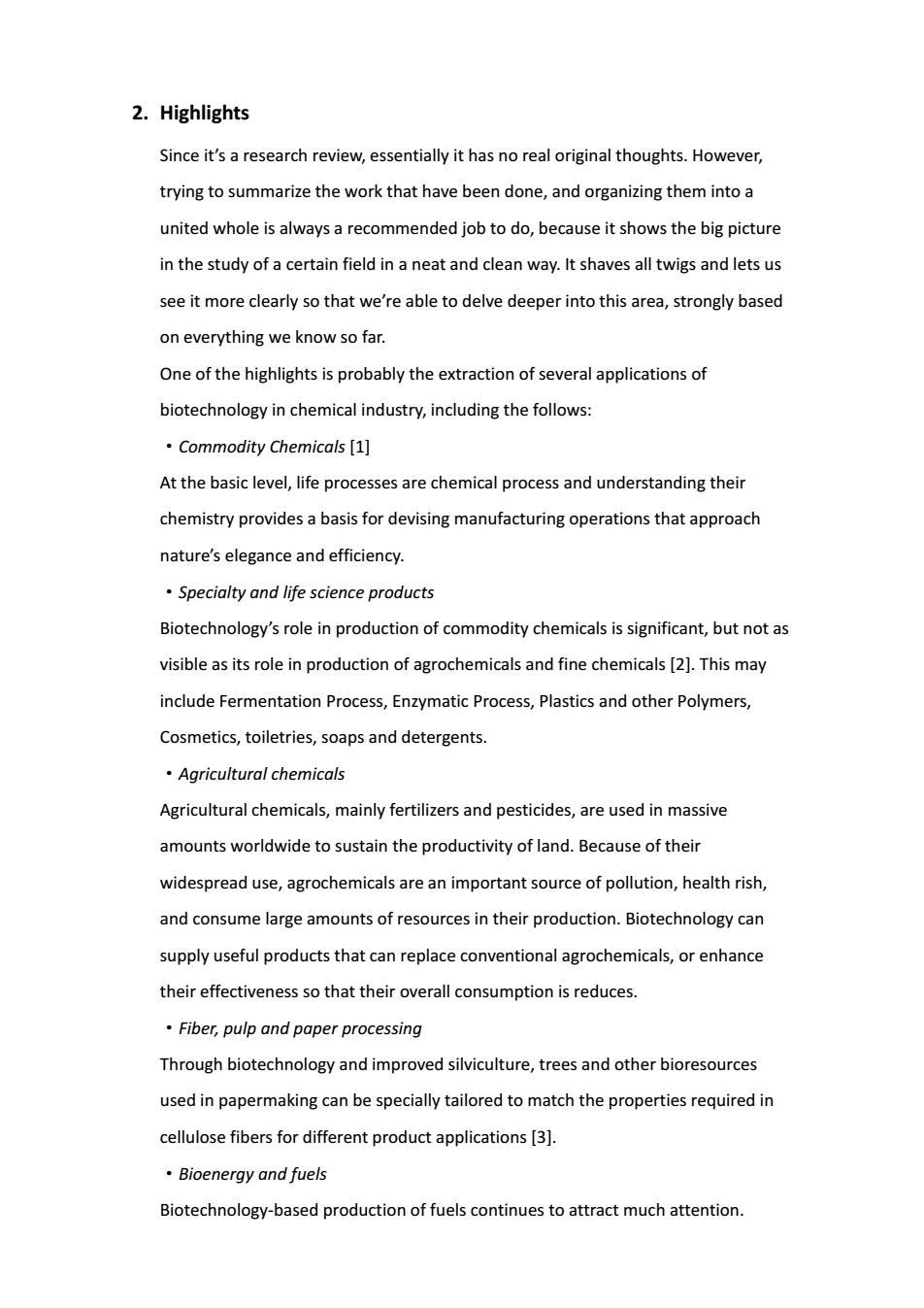
2.Highlights Since it's a research review,essentially it has no real original thoughts.However, trying to summarize the work that have been done,and organizing them into a united whole is always a recommended job to do,because it shows the big picture in the study of a certain field in a neat and clean way.It shaves all twigs and lets us see it more clearly so that we're able to delve deeper into this area,strongly based on everything we know so far. One of the highlights is probably the extraction of several applications of biotechnology in chemical industry,including the follows: Commodity Chemicals [1] At the basic level,life processes are chemical process and understanding their chemistry provides a basis for devising manufacturing operations that approach nature's elegance and efficiency. Specialty and life science products Biotechnology's role in production of commodity chemicals is significant,but not as visible as its role in production of agrochemicals and fine chemicals [2].This may include Fermentation Process,Enzymatic Process,Plastics and other Polymers, Cosmetics,toiletries,soaps and detergents. Agricultural chemicals Agricultural chemicals,mainly fertilizers and pesticides,are used in massive amounts worldwide to sustain the productivity of land.Because of their widespread use,agrochemicals are an important source of pollution,health rish, and consume large amounts of resources in their production.Biotechnology can supply useful products that can replace conventional agrochemicals,or enhance their effectiveness so that their overall consumption is reduces. Fiber,pulp and paper processing Through biotechnology and improved silviculture,trees and other bioresources used in papermaking can be specially tailored to match the properties required in cellulose fibers for different product applications [3]. ·Bioenergy and fuels Biotechnology-based production of fuels continues to attract much attention
2. Highlights Since it’s a research review, essentially it has no real original thoughts. However, trying to summarize the work that have been done, and organizing them into a united whole is always a recommended job to do, because it shows the big picture in the study of a certain field in a neat and clean way. It shaves all twigs and lets us see it more clearly so that we’re able to delve deeper into this area, strongly based on everything we know so far. One of the highlights is probably the extraction of several applications of biotechnology in chemical industry, including the follows: ·Commodity Chemicals [1] At the basic level, life processes are chemical process and understanding their chemistry provides a basis for devising manufacturing operations that approach nature’s elegance and efficiency. ·Specialty and life science products Biotechnology’s role in production of commodity chemicals is significant, but not as visible as its role in production of agrochemicals and fine chemicals [2]. This may include Fermentation Process, Enzymatic Process, Plastics and other Polymers, Cosmetics, toiletries, soaps and detergents. ·Agricultural chemicals Agricultural chemicals, mainly fertilizers and pesticides, are used in massive amounts worldwide to sustain the productivity of land. Because of their widespread use, agrochemicals are an important source of pollution, health rish, and consume large amounts of resources in their production. Biotechnology can supply useful products that can replace conventional agrochemicals, or enhance their effectiveness so that their overall consumption is reduces. ·Fiber, pulp and paper processing Through biotechnology and improved silviculture, trees and other bioresources used in papermaking can be specially tailored to match the properties required in cellulose fibers for different product applications [3]. ·Bioenergy and fuels Biotechnology-based production of fuels continues to attract much attention
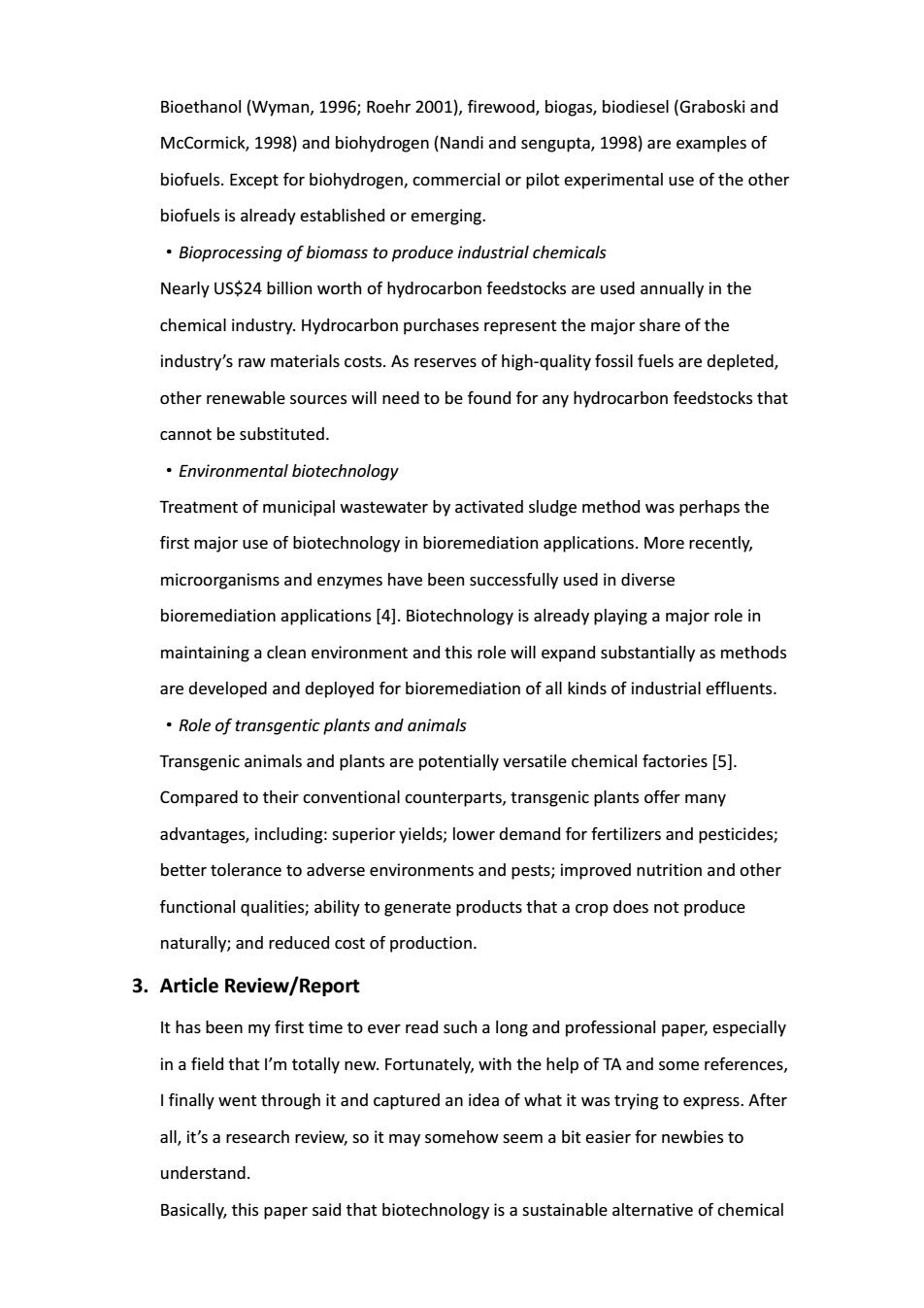
Bioethanol(Wyman,1996;Roehr 2001),firewood,biogas,biodiesel(Graboski and McCormick,1998)and biohydrogen(Nandi and sengupta,1998)are examples of biofuels.Except for biohydrogen,commercial or pilot experimental use of the other biofuels is already established or emerging. Bioprocessing of biomass to produce industrial chemicals Nearly US$24 billion worth of hydrocarbon feedstocks are used annually in the chemical industry.Hydrocarbon purchases represent the major share of the industry's raw materials costs.As reserves of high-quality fossil fuels are depleted, other renewable sources will need to be found for any hydrocarbon feedstocks that cannot be substituted. Environmental biotechnology Treatment of municipal wastewater by activated sludge method was perhaps the first major use of biotechnology in bioremediation applications.More recently, microorganisms and enzymes have been successfully used in diverse bioremediation applications [4].Biotechnology is already playing a major role in maintaining a clean environment and this role will expand substantially as methods are developed and deployed for bioremediation of all kinds of industrial effluents. Role of transgentic plants and animals Transgenic animals and plants are potentially versatile chemical factories [5]. Compared to their conventional counterparts,transgenic plants offer many advantages,including:superior yields;lower demand for fertilizers and pesticides; better tolerance to adverse environments and pests;improved nutrition and other functional qualities;ability to generate products that a crop does not produce naturally;and reduced cost of production. 3.Article Review/Report It has been my first time to ever read such a long and professional paper,especially in a field that I'm totally new.Fortunately,with the help of TA and some references, I finally went through it and captured an idea of what it was trying to express.After all,it's a research review,so it may somehow seem a bit easier for newbies to understand. Basically,this paper said that biotechnology is a sustainable alternative of chemical
Bioethanol (Wyman, 1996; Roehr 2001), firewood, biogas, biodiesel (Graboski and McCormick, 1998) and biohydrogen (Nandi and sengupta, 1998) are examples of biofuels. Except for biohydrogen, commercial or pilot experimental use of the other biofuels is already established or emerging. ·Bioprocessing of biomass to produce industrial chemicals Nearly US$24 billion worth of hydrocarbon feedstocks are used annually in the chemical industry. Hydrocarbon purchases represent the major share of the industry’s raw materials costs. As reserves of high-quality fossil fuels are depleted, other renewable sources will need to be found for any hydrocarbon feedstocks that cannot be substituted. ·Environmental biotechnology Treatment of municipal wastewater by activated sludge method was perhaps the first major use of biotechnology in bioremediation applications. More recently, microorganisms and enzymes have been successfully used in diverse bioremediation applications [4]. Biotechnology is already playing a major role in maintaining a clean environment and this role will expand substantially as methods are developed and deployed for bioremediation of all kinds of industrial effluents. ·Role of transgentic plants and animals Transgenic animals and plants are potentially versatile chemical factories [5]. Compared to their conventional counterparts, transgenic plants offer many advantages, including: superior yields; lower demand for fertilizers and pesticides; better tolerance to adverse environments and pests; improved nutrition and other functional qualities; ability to generate products that a crop does not produce naturally; and reduced cost of production. 3. Article Review/Report It has been my first time to ever read such a long and professional paper, especially in a field that I’m totally new. Fortunately, with the help of TA and some references, I finally went through it and captured an idea of what it was trying to express. After all, it’s a research review, so it may somehow seem a bit easier for newbies to understand. Basically, this paper said that biotechnology is a sustainable alternative of chemical
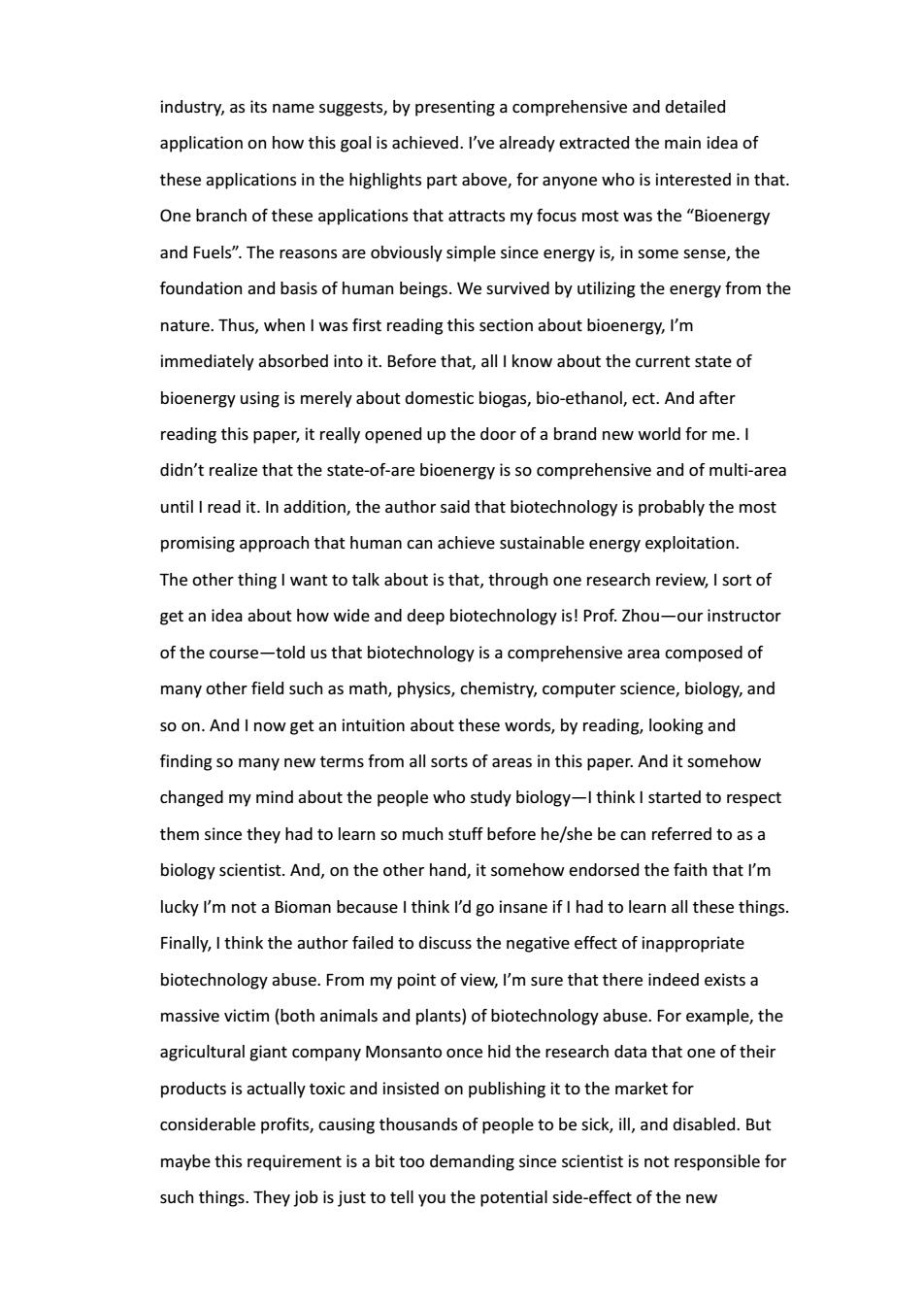
industry,as its name suggests,by presenting a comprehensive and detailed application on how this goal is achieved.I've already extracted the main idea of these applications in the highlights part above,for anyone who is interested in that. One branch of these applications that attracts my focus most was the "Bioenergy and Fuels".The reasons are obviously simple since energy is,in some sense,the foundation and basis of human beings.We survived by utilizing the energy from the nature.Thus,when I was first reading this section about bioenergy,I'm immediately absorbed into it.Before that,all I know about the current state of bioenergy using is merely about domestic biogas,bio-ethanol,ect.And after reading this paper,it really opened up the door of a brand new world for me.I didn't realize that the state-of-are bioenergy is so comprehensive and of multi-area until I read it.In addition,the author said that biotechnology is probably the most promising approach that human can achieve sustainable energy exploitation. The other thing I want to talk about is that,through one research review,i sort of get an idea about how wide and deep biotechnology is!Prof.Zhou-our instructor of the course-told us that biotechnology is a comprehensive area composed of many other field such as math,physics,chemistry,computer science,biology,and so on.And I now get an intuition about these words,by reading,looking and finding so many new terms from all sorts of areas in this paper.And it somehow changed my mind about the people who study biology-I think I started to respect them since they had to learn so much stuff before he/she be can referred to as a biology scientist.And,on the other hand,it somehow endorsed the faith that I'm lucky I'm not a Bioman because I think I'd go insane if I had to learn all these things. Finally,I think the author failed to discuss the negative effect of inappropriate biotechnology abuse.From my point of view,I'm sure that there indeed exists a massive victim(both animals and plants)of biotechnology abuse.For example,the agricultural giant company Monsanto once hid the research data that one of their products is actually toxic and insisted on publishing it to the market for considerable profits,causing thousands of people to be sick,ill,and disabled.But maybe this requirement is a bit too demanding since scientist is not responsible for such things.They job is just to tell you the potential side-effect of the new
industry, as its name suggests, by presenting a comprehensive and detailed application on how this goal is achieved. I’ve already extracted the main idea of these applications in the highlights part above, for anyone who is interested in that. One branch of these applications that attracts my focus most was the “Bioenergy and Fuels”. The reasons are obviously simple since energy is, in some sense, the foundation and basis of human beings. We survived by utilizing the energy from the nature. Thus, when I was first reading this section about bioenergy, I’m immediately absorbed into it. Before that, all I know about the current state of bioenergy using is merely about domestic biogas, bio-ethanol, ect. And after reading this paper, it really opened up the door of a brand new world for me. I didn’t realize that the state-of-are bioenergy is so comprehensive and of multi-area until I read it. In addition, the author said that biotechnology is probably the most promising approach that human can achieve sustainable energy exploitation. The other thing I want to talk about is that, through one research review, I sort of get an idea about how wide and deep biotechnology is! Prof. Zhou—our instructor of the course—told us that biotechnology is a comprehensive area composed of many other field such as math, physics, chemistry, computer science, biology, and so on. And I now get an intuition about these words, by reading, looking and finding so many new terms from all sorts of areas in this paper. And it somehow changed my mind about the people who study biology—I think I started to respect them since they had to learn so much stuff before he/she be can referred to as a biology scientist. And, on the other hand, it somehow endorsed the faith that I’m lucky I’m not a Bioman because I think I’d go insane if I had to learn all these things. Finally, I think the author failed to discuss the negative effect of inappropriate biotechnology abuse. From my point of view, I’m sure that there indeed exists a massive victim (both animals and plants) of biotechnology abuse. For example, the agricultural giant company Monsanto once hid the research data that one of their products is actually toxic and insisted on publishing it to the market for considerable profits, causing thousands of people to be sick, ill, and disabled. But maybe this requirement is a bit too demanding since scientist is not responsible for such things. They job is just to tell you the potential side-effect of the new
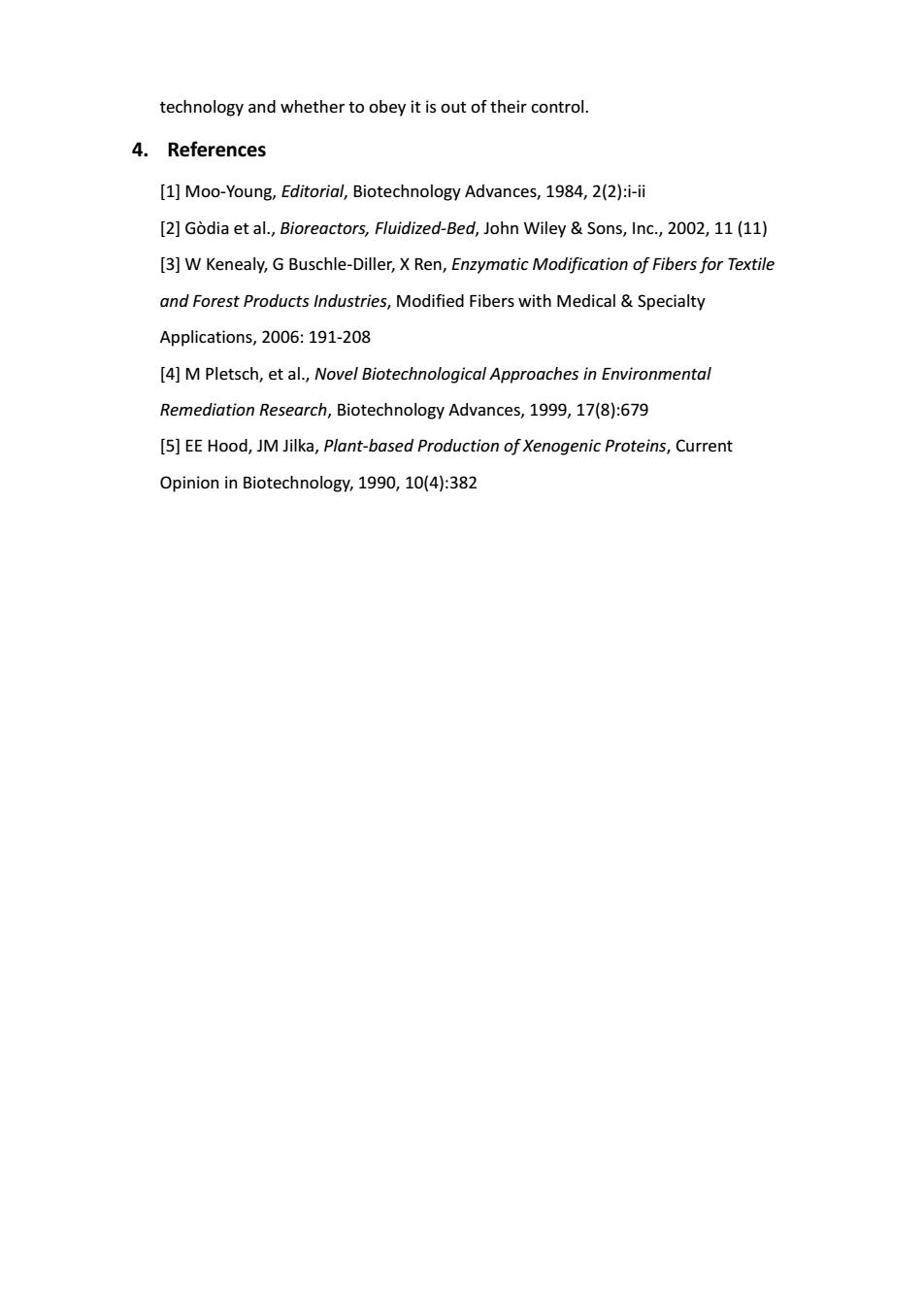
technology and whether to obey it is out of their control. 4.References [1]Moo-Young,Editorial,Biotechnology Advances,1984,2(2):i-ii [2]Godia et al.,Bioreactors,Fluidized-Bed,John Wiley Sons,Inc.,2002,11(11) [3]W Kenealy,G Buschle-Diller,X Ren,Enzymatic Modification of Fibers for Textile and Forest Products Industries,Modified Fibers with Medical Specialty Applications,2006:191-208 [4]M Pletsch,et al.,Novel Biotechnological Approaches in Environmental Remediation Research,Biotechnology Advances,1999,17(8):679 [5]EE Hood,JM Jilka,Plant-based Production of Xenogenic Proteins,Current Opinion in Biotechnology,1990,10(4):382
technology and whether to obey it is out of their control. 4. References [1] Moo-Young, Editorial, Biotechnology Advances, 1984, 2(2):i-ii [2] Gòdia et al., Bioreactors, Fluidized-Bed, John Wiley & Sons, Inc., 2002, 11 (11) [3] W Kenealy, G Buschle-Diller, X Ren, Enzymatic Modification of Fibers for Textile and Forest Products Industries, Modified Fibers with Medical & Specialty Applications, 2006: 191-208 [4] M Pletsch, et al., Novel Biotechnological Approaches in Environmental Remediation Research, Biotechnology Advances, 1999, 17(8):679 [5] EE Hood, JM Jilka, Plant-based Production of Xenogenic Proteins, Current Opinion in Biotechnology, 1990, 10(4):382